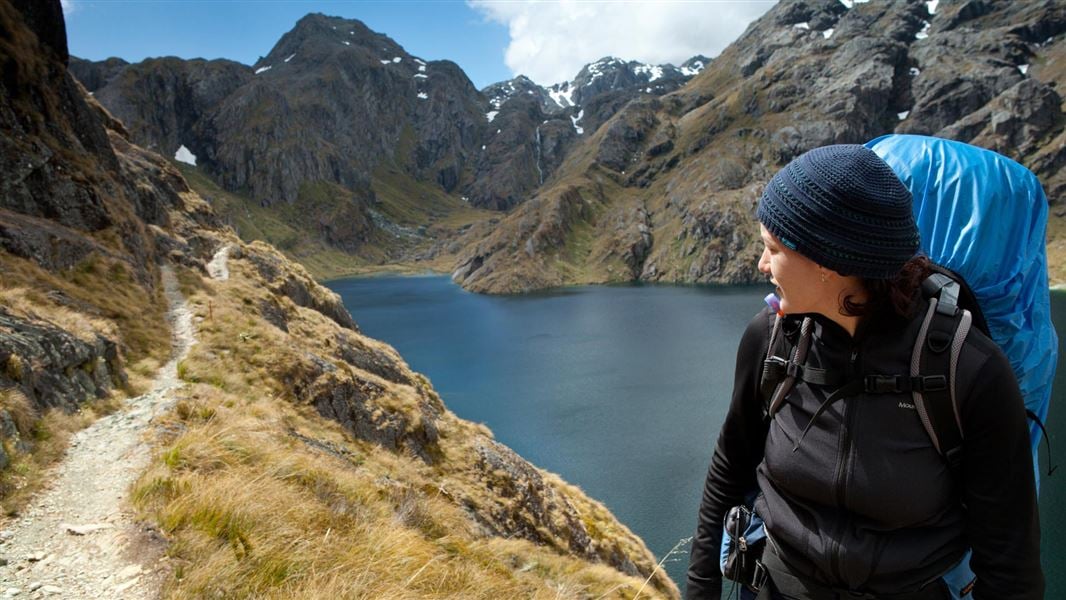Archived content: This media release was accurate on the date of publication.
Date: 07 December 2020
The Routeburn Track, one of New Zealand's most historic tracks and the alpine pathway between the Fiordland and Whakatipu communities, has officially reopened end to end.
DOC Operations Director southern South Island Aaron Fleming says from today, visitors booked on the popular Great Walk will be able to start their hike at either the Te Anau or Glenorchy end of the track and walk to the other end for the first time since early February.
"The reopening of the Routeburn Track is another crucial milestone in the flood recovery work taking place in the Fiordland and Mt Aspiring National Parks, after the Milford Track was reopened last week.
"This announcement celebrates the huge amount of work done to open these iconic tracks, which now means that all three Great Walks in Fiordland are open and ready for visitors. Many DOC staff and contractors have worked hard to get the track to a point where we can now safely reopen it end to end."
It is fantastic to have the full suite of southern Great Walks open to support their communities once more, Aaron says
"The Fiordland and the Whakatipu communities have had a difficult year. Having these tracks reopened not only encourages people to connect with nature, but encourages visitors back into this incredible part of the country."
The Routeburn Track spans across two National Parks – Mt Aspiring National Park and Fiordland National Park with the border and highest point being the Harris Saddle.
It was among the 78 tracks damaged in the February 2020 floods.
A three-day storm saw one tenth of the region's average annual rainfall dump on northern Fiordland between 4–6 February. This sparked a major search and rescue operation, damaged 440 km of tracks and wiped out key infrastructure including parts of the Milford Road.
Lake Howden Hut on the Fiordland section of the Routeburn Track was hit by a landslide in the middle of the night on the 4 November.
The hut was so badly damaged that it was deemed unsafe to repair and was closed immediately. It has since been demolished and removed from the park. The site was remediated and the track realigned.
"We'll work with our partners and stakeholders to develop the long-term plan for the Lake Howden site," Aaron Fleming says.
The Routeburn Track has a very rich history and is an important feature of Te Wāhipounamu - South West New Zealand World Heritage Area.
The Routeburn Track is popular as the easy access (by vehicle) to either end means walkers can start at one end and then either catch a transport shuttle or have their vehicle moved by one of the car relocation companies to the other end.
$13.7 million was announced in Budget 2020 to go towards repairing vital conservation and visitor infrastructure destroyed in the February flood.
Bookings on the track are in high demand with the holiday period almost at capacity. Walkers should check the DOC website for details on what dates are still available.
All visitors are asked to follow all signs and instructions while on the track.
Background information
The Greenstone and Routeburn valleys were both used by Māori as routes to the West Coast to look for pounamu, as well as travelling to a quarry at the head of Lake Whakatipu.
West Coast, East Coast and Southern Māori are recorded as having used these routes.
The valleys and passes of old trails were connected to make tracks in the Humboldt, Ailsa and Livingstone Mountains. These tracks are now known as the Routeburn, Greenstone and Caples. They can be walked as individual tracks or joined up to make circular routes.
Lake Howden has long been an important junction for those three tracks. The first camp was recorded as being established there in 1889 by Surveyor E. H. Wilmot. The first permanent dwelling was erected in 1918 and then repaired and extended in 1950.
The Routeburn track, and neighboring trails, had guided tours operators on them for many years from the 1930's. The 1935 Lake Howden Hut caretaker would charge 10 c per night.
The Hut that was removed this month was the third one on that site. It was built in the winter of 1982 by DOC personnel. The weather conditions were so severe that hammered nails split the frozen timber or simply bent. Lake Howden was observed to be frozen to a thickness of 140 mm during July while the hut was being built.
Completing repairs across all damaged tracks in the SSI region is estimated to be a three-year programme.
The Kepler Track is the third Great Walk in Fiordland and it was not affected by the storm. It was able to keep operating until the March 2020 COVID-19 lockdown but opened again as normal for the Great Walks season on 27 October.
DOC personnel managed the design and installation of the five new bridges on the track between Lake Howden and Lake Mackenzie Hut.
Contractors
WestReef Services have been on the Routeburn Track since September repairing the damage from all the landslips and reinstating the track.
Abseil Access rebuilt a key suspension bridge (Twin Bridge) on the Routeburn Track (Mt Aspiring NP side).
Glacier Southern Lake Helicopters were contracted for the removal of Lake Howden Hut in late November.
Contractors local to Te Anau and Glenorchy have completed repair work on repairing the Routeburn Track – Te Anau Earthworks Ltd in the west (the Divide slip) and John Henderson Construction Ltd in the east (Mt Aspiring NP side).
Contact
For media enquiries contact:
Email: media@doc.govt.nz
